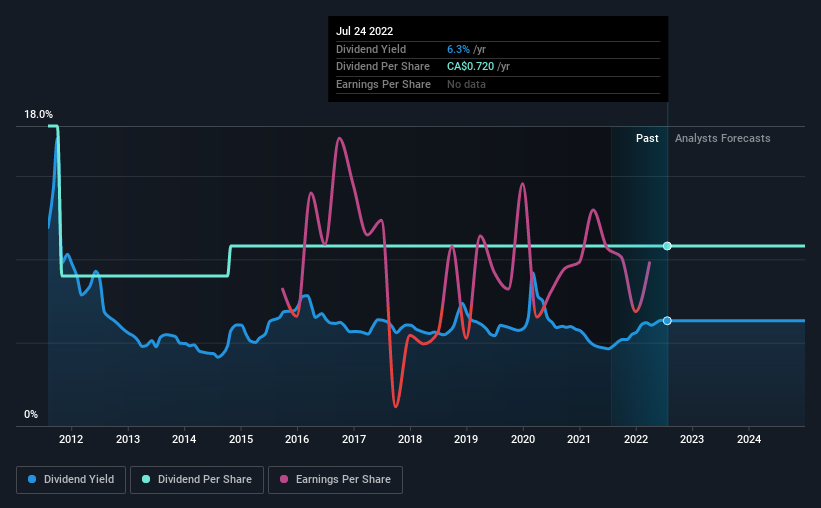
Superior Plus Corp. (TSE:SPB) has announced that it will pay a dividend of CA$0.06 per share on the 15th of August. This makes the dividend yield 6.3%, which will augment investor returns quite nicely.
See our latest analysis for Superior Plus
Superior Plus' Payment Has Solid Earnings Coverage
If the payments aren't sustainable, a high yield for a few years won't matter that much. Based on the last payment, the company wasn't making enough to cover what it was paying to shareholders. This situation certainly isn't ideal, and could place significant strain on the balance sheet if it continues.
The next 12 months could see EPS growing very rapidly. Assuming the dividend continues along the path it has been on, the payout ratio could get to 86% which is certainly still sustainable.

Superior Plus' Track Record Isn't Great
The dividend is currently lower than it was 10 years ago, indicating that there has been a downward trend over that time. The annual payment during the last 10 years was CA$1.20 in 2012, and the most recent fiscal year payment was CA$0.72. The dividend has shrunk at around 5.0% a year during that period. A company that decreases its dividend over time generally isn't what we are looking for.
The Dividend Has Limited Growth Potential
With a relatively unstable dividend, it's even more important to see if earnings per share is growing. Over the past five years, it looks as though Superior Plus' EPS has declined at around 12% a year. A sharp decline in earnings per share is not great from from a dividend perspective. Even conservative payout ratios can come under pressure if earnings fall far enough. Over the next year, however, earnings are actually predicted to rise, but we would still be cautious until a track record of earnings growth can be built.
We should note that Superior Plus has issued stock equal to 15% of shares outstanding. Regularly doing this can be detrimental - it's hard to grow dividends per share when new shares are regularly being created.
Superior Plus' Dividend Doesn't Look Sustainable
In summary, while it's good to see that the dividend hasn't been cut, we are a bit cautious about Superior Plus' payments, as there could be some issues with sustaining them into the future. In the past the payments have been stable, but we think the company is paying out too much for this to continue for the long term. Overall, we don't think this company has the makings of a good income stock.
Market movements attest to how highly valued a consistent dividend policy is compared to one which is more unpredictable. Meanwhile, despite the importance of dividend payments, they are not the only factors our readers should know when assessing a company. Case in point: We've spotted 5 warning signs for Superior Plus (of which 2 make us uncomfortable!) you should know about. If you are a dividend investor, you might also want to look at our curated list of high yield dividend stocks.
New: Manage All Your Stock Portfolios in One Place
We've created the ultimate portfolio companion for stock investors, and it's free.
• Connect an unlimited number of Portfolios and see your total in one currency
• Be alerted to new Warning Signs or Risks via email or mobile
• Track the Fair Value of your stocks
Have feedback on this article? Concerned about the content? Get in touch with us directly. Alternatively, email editorial-team (at) simplywallst.com.
This article by Simply Wall St is general in nature. We provide commentary based on historical data and analyst forecasts only using an unbiased methodology and our articles are not intended to be financial advice. It does not constitute a recommendation to buy or sell any stock, and does not take account of your objectives, or your financial situation. We aim to bring you long-term focused analysis driven by fundamental data. Note that our analysis may not factor in the latest price-sensitive company announcements or qualitative material. Simply Wall St has no position in any stocks mentioned.
About TSX:SPB
Superior Plus
Distributes and markets propane, compressed natural gas and renewable energy in both the United States and Canada.
Reasonable growth potential low.


